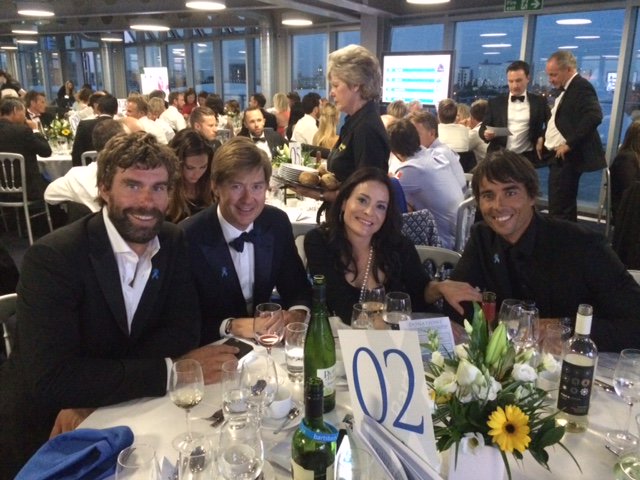Raj Girn: My guest today is the founder of Aquila Capital Partners. Mark Watson, who through his many endeavors, has invested in numerous startups, helping several of them scale and 10x their revenue throughout his three decades long experience. Mark has also run two public companies with over $3.5 billion in revenue, hired thousands of people across continents and navigated through major world crisis. Today, I have the distinct pleasure of picking his brain so that all of you watching, listening and reading this can garner his wisdom as a powerful and innovative leader.
Here is our conversation:

Raj Girn: Mark, thank you for agreeing to be on the show. What a treat you are to me and the audience.
Mark E. Watson: Well, Raj, it’s a real pleasure to be here. I’m a little nervous about that intro, though, what you might ask.
It’s funny because when people talk about all the things we have done over decades in the span of a paragraph, it seems unbelievable that that’s really you. But that’s really you, Mark.
Yeah, you know, it’s funny you say that. I remember when I was early in my career looking at the CVs of speakers at conferences I would go to, and I would just think: Gosh, how did they have time to do all that? And you look back in hindsight and you’re like, “Oh, well, actually, there’s a lot to do, isn’t there?”
Yes, absolutely. So let’s start there Mark. I’d like to begin by asking you to share why entrepreneurship specifically was your chosen path. Why? Are you crazy is really the question I want to ask?

Well, I’ll tell you what, I don’t know if entrepreneurship chose me or I chose it, or it just kind of happened. And I’ll tell you, I say that ever since I was a kid, I was always trying to make a buck and I was always trying to figure out a more creative way than my friends or others to make a buck.
I’ll give you a great example. When we were in elementary school, I had a friend that was really very artsy and he used to draw these magazines. And I’m like, “What are you going to do with that?” And he’s like, “I don’t know.” And I’m like, “Can I buy it from you?” And he’s like, “Okay.” And so I pay him 10 cents for it, and I’d sell it for a quarter. And of course, he finally caught on and he’s like, “Well, why can’t I go sell it for a quarter?” And I’m like “Because you don’t know who to sell it to?” And by the way, I’m now dating myself, right? So this is back when that was a fair amount of money.
Of course, I used to go buy candy and resell it to friends. I had a paper route. I mowed yards and I also had a home renovation company. But what I figured out was that I could go hire my friends to go mow the yards and do the painting, and I could then go collect more customers and get a little dig off the top. And I also learned from the magazine thing to just take a little bit because then people didn’t want to go through the effort of finding the customer themselves.
And so, it’s just that’s kind of always been a part of it. And then I started thinking about it, because other people have asked me this question, and I realized that I learned a lot around the dinner table. My mother was my family’s dinner table or my friend’s family’s dinner table. My father, grandfathers, my friends’ fathers or mothers were all entrepreneurs. And so I grew up in a very entrepreneurial environment, not just with my family, but with my friends as well. And so I think a lot of that just kind of rubbed off.
Now I also tell someone this the other day, I was like, if I was sitting with a bunch of astrophysicists, I’m not sure that I would have become an astrophysicist. But you know, I like building things and entrepreneurship is building businesses and I also am a very creative person. By the way, that means executions are not my favorite thing. I like strategy and creating stuff, and I’m sure we’ll get more into that. But I just like building stuff. And what I realized is that I’ve kind of been doing it all my life, and I’m now trying to instill that in my children, which is easier said than done.
Yes, I hear you. And it seems like it’s easy, but it’s not because it’s one of those things that it’s either in your DNA or it isn’t. And I know that people say that most things in life you can learn. But you know, it’s so much easier when you know the passion is already there within you. And that’s why I wanted to ask you about your company Aquila. It focuses on supporting startups in a number of arenas that have one common denominator that they must be purpose driven. Can you share how the decision is made as to what types of companies and stages of growth you invest in and why? The big WHY.
Well, that’s that’s a lot of questions. So we’re mainly focused on early stage companies, and of course, that can be pretty broad, right? If I think about it in BC speak, it means seed round or a round, but to say it more generally, it’s companies that they’ve figured out their product. They’ve got a few customers. They’re struggling with their go to market strategy. They think they’re really on to something that they could scale, but they’re not quite sure why they can’t scale. And they’ve either really solved the problem in the world or built an amazing product that people want.

And I have to say, as we become successful over the last few years in investing . . . And actually I started Aquila more than a couple of decades ago, but then I started running my second investment and that took on a life of its own and now I’m back to to early stage investing again. And this time around, I’m trying to find companies that really are new. They’re innovative, they’ll make a difference in society. They make society better in some way. Hopefully, it’s not just a meta of another business that’s already out there. How many new businesses have you seen that have something else or a team of people left their employer to go start something new.
And it’s like, “What are you doing different?” I can’t tell you how many management teams used to come to me when I was running my company before. And they’re like, “We want to come work for you and do X. And I’m like, “Why do you want to do that?” “Because you have a good brand?” I’m like, “Well, that’s true. What are you going to do?” “Well, we’re going to do the same thing we did before.” And I’m like, “Why? The world doesn’t need that.”
And that’s the hardest thing, right, Mark? That’s the hardest thing to find the innovative piece. Or maybe it’s not just an innovative product, but it’s an innovative way of using that product.
Yeah. Or how to go to market. And I think what you just hit on is so true, which is people think a lot of things about . . . They think two things in particular about innovation. One, they think it’s like invention. And no, innovation is just figuring out how to do something different than it’s being done today. Right? And by the way, some of the most amazing innovations are just incremental and change, and they can be about process, not product. Right?
“The innovation is just figuring out how to do something different than it’s being done today. And some of the most amazing innovations are just incremental and change, and they can be about process, not product.” ~Mark E. Watson
Some of the coolest things we did at my other company was how we went to the capital markets to raise money. And we did so in a very unconventional way. Yes, we were a public company and we would issue equity and we would issue debt. But we also found business partners that we could leverage their balance sheet as well. And that was actually one of the more innovative things that we ever did. But just getting back to venture and small companies.
We live in a time right now where we’re not just going through these cyclical changes in the economy. The economy is changing massively. It was already starting before COVID hit, and that really forced us to digitize our economy overnight. And so what I think would have taken another five years took five quarters. And so you look at all these new companies that have been launched that are digital in nature. And by the way, I don’t mean to say that there are technology companies, although some of my portfolio companies are, but many more of them are what I call tech enabled companies. They’re traditional business models that have figured out how to use technology to digitize their platform, which makes them perhaps not infinitely scalable but much more scalable than they were before.
Absolutely. And it’s really interesting you say that because when COVID hit, as a media specialist, I had a lot of CEOs, entrepreneurs, small company leaders coming to me and saying, “I need to somehow engage audiences that don’t know who we are and I need to do it without being able to see them.” So i.e. the virtual world. So there was an opportunity for me, Mark, to open up my Academy, The Open Chest Confidence Academy.
The reason why, to your point, that I’ve even been able to have it grow to the point I have so quickly other than there being a demand, is that we have 80 per cent of the business automated. And that’s where the technology piece is helping us to create functionality that allows us to be able to access flexibility with what we’re trying to accomplish and with the types of people we’re trying to accomplish that with. This is absolutely necessary on some level with every company and that’s something that we’re seeing is happening rapidly. What is your take on where that’s gonna go?
Well, I have to tell you, I actually have a different answer today than I did a month ago. The world of digitization will continue. But here’s what I think is also coming next. And I was listening to a podcast of Tim Ferriss interviewing Mark Zuckerberg, and he was talking about the metaverse. And most of us all think about the metaverse in a gaming way. And he was talking about some of the business applications that they use at his company and how they’re actually able to engage each other in their virtual world through, I think this is the case but I’m not sure, their own avatars that they’ve created.
And what he said is actually, there will be a day when you can actually have a virtual meeting in your virtual conference room where you’ll actually do a better job of understanding people’s body language and intonation than what we do today. When we use Zoom and you’ve got Hollywood Squares up on your monitor right in and you’ll be able to kind of look left and right and and collaborate better. And I thought I would never have guessed that and I’m a creative, imaginative person. I started thinking, well, actually, that would be kind of cool because the Hollywood Squares thing is, like you and I are talking right now, great. I can see you or I can understand what you’re thinking a little bit about your body language and probably the other way around.

But when you’ve got 20 people on the screen and everybody’s this big, forget it. So video’s great one-on-one or a couple of things. But I think that how we continue to engage each other is going to evolve. And I think that’s what we’re trying to figure out now is what’s the right cadence to engage each other in person or virtually or by writing? I mean, we still write each other on occasion, right?
So figuring out that cadence and of course, all these things lead to new businesses and new business models and I actually get more excited that there’s more investment opportunity coming with more new things. Then all of a sudden we’re all going to be forced onto the matrix. I just I think we’re all worried about that a few years ago. I don’t worry about that now. I get excited about what’s coming next.
While I just think it’s a different matrix. I think that there’s always been a generation that has felt that they’re being pushed into a matrix. So I think it’s all kind of context. It’s the world that you knew before The Matrix came along, whatever that may be. And I’m sure that was just keep changing as we keep creating more ways of looking at things that we can do. I think that’s what the dumbed down version for me is, you know?
Well, you know, when I look at companies that I think have the most success going forward, they’re all run by people that are intellectually curious. They’re very interested in learning new things, or maybe to say it differently, they’re not opposed to learning new things. I belong to a group called YPO, which stands for Young Presidents Organization, and one of our taglines is a lifetime of learning. And I was actually on a call yesterday, and I think the average age of the person on the call was probably, I don’t know, mid 50s. And we’re all pressing each other about new things that we’re trying to think about and learn and so I’m just curious today, as I was before. And I like finding other people that are equally curious because I know that when they hit the wall, they’re going to figure it out. And also, they’re not afraid to pick up the phone and call.
Absolutely. That’s what it is. It’s not just finding the opportunity, but finding people that are as curious and as insightful and as open minded as you could ever be.
Yeah, open minded really matters a lot.
Yeah, absolutely. I want to ask you this. For all those people out there who would expect me to ask this question to someone like you as an investor. When do you think entrepreneurs should consider raising capital and for what reason? People feel that if I were an entrepreneur, they have to raise money and then how much do I raise and where am I putting it? Talk to me about this.
Yeah, well. So the first answer is don’t go raise money when you’re out of money. Remember 20 years ago when Dell Computers became famous, their just in time supply chain model.
You know what’s happened to everybody that had just in time supply chain models the last two years, what not good things? They couldn’t get their product to market because they couldn’t get the parts. One time we were getting a little tight on cash and my investment banker said to me, “Mark, you don’t need to run your capital structure on just in time financing.” And I’m like, “I know I got that.” And so you always want to raise money when you don’t need it.
“Don’t go raise money when you’re out of money” ~Mark E. Watson
I love that. That’s that is the piece of advice that every entrepreneur needs to hear that they don’t talk about.
Well, listen, it’s always good to understand what your cash flow is or what your capital structure is and what your capital needs are. But then also, I’ll tell you an interesting thing to think about, and that is a lot of times entrepreneurs don’t need capital, depending on their growth rate and or their cash burn. And I think so many companies today, they think that if they don’t go raise money in the venture world and they can’t say, “Hey, we just did our series seed in our series A and our Series B,” that like all of a sudden, when you ask them what their goal is for their company . . . I can’t tell you how many entrepreneurs we’ve talked to, very briefly I might add.
They’ll say, “Well, our goal is to get to the next round.” And I’m like, “That’s not a goal.” I mean, that’s not a business goal. That’s because you’re growing, you need money, I know. “But we’ll be validated once we get to our B round.” And then I realize they’re serious. And so look, if you figure it out, a really new product or service and you have massive demand and you want to make sure that you can fulfill that demand immediately so you don’t mess up your brand, then you may need to go raise some capital to help you grow fast enough to fill demand.
But how many times have we heard in the last couple of years, and this is more true I think of public companies, that went and look at all these companies that a year ago, IPO, their share price doubled and all of a sudden they had multibillion dollar valuations. And on the next earnings call, the CEO would say that they’re trying to figure out new products and services to offer their customers to grow into their valuation.

By the way, all those companies are now trading at 20 per cent of what they were a year ago, on average. And and so having money is a dangerous thing. I remember during the dot com bubble and in 1999, 2000, 2001, all these startups, pre-revenue companies raised all this money on their PowerPoints, and they would immediately go spend the money on an amazing office and they’d hire a chef in the kitchen. And I’m like, “Well, what are you going to…? What’s your product?” “We’re working on that.” And I’m like, “Oh, okay.” And you see a little of that now. By the way, that’s fading very rapidly.
And so I think that having access to capital is one thing but making sure that you have the use of proceeds that’s actually going to return, it’s going to generate a return on the investor that gave it to you really matters a lot as opposed to you’re just fueling the beast until the next round.
And so there are a lot of companies right now, but that once you add up their cost of acquiring a customer, they may not actually be viable, and we saw the same thing 20 years ago. There aren’t as many of them now, but I think knowing where the money will come from if you need it is really helpful. So always talking to investors is really helpful. But making sure that you’ve got an amazing product or service that delights your customer and knowing how fast to grow or not.
Another thing I would say that I think is equally important to the first thing is if you grow too fast, there’s a really good chance that your burn rate’s not going to keep up with the amount of capital. And so then you’ve got to go raise capital and you’re not in a very good spot.
“If you grow too fast, there’s a really good chance that your burn rate’s not going to keep up with the amount of capital. And so then you’ve got to go raise capital and you’re not in a very good spot.” ~Mark E. Watson
Yeah absolutely. Can I ask you this? What should companies be aware of regarding the challenges that come with scaling a company like you’ve done time and time again. You’ve 10x numerous companies. You’ve assisted in that. What do they need to know that they don’t know when they’re going in?
Well, we just talked about a couple of them, right? This cadence of how quickly to grow. One, we were just talking about it in terms of a burn rate and making sure you don’t run out of money. But also the other challenge that I’ve seen with companies, and by the way this was certainly true of some of my subsidiaries, was that you sometimes grow faster than your organizational structure and you sometimes grow and perhaps you can keep the companies structure. Perhaps you can reorganize yourself to keep growing at the rate of the company. But then the people that were in the roles aren’t necessarily in alignment with the new role after the company grew.
I’ll tell a great story. I go back 20 years ago and I was talking to somebody who has become a wonderful advisor to me. His name is Ram Charan, and he’s written a dozen business books. The most important, story, probably the most popular one that you heard of was ‘Execution’ that he coauthored with Larry Bossidy when Larry Bossidy had just left GE. And so one of my colleagues tracked him down, and so we are sitting together in a coffee shop, and he said, “Let me ask the question; you’re trying to build your company?” And I said, “Yes.” and he goes, “You understand that the world around you evolves.” And I said, “Yes.” And he goes, “So you’ve got to evolve your company.” And my new things weren’t changing nearly as quickly as they are right now. So if you successfully change your company, then you probably have to change the way you run it. And I said, “Right.” And he said, “That means that all of you and your team, if you can’t change the way you do things, you might get left behind.” I’m like, “Got it.” And I’m like, “No, no, really. I got it.” And so to me, that’s always the biggest challenge with with fast growing companies is can the team and the org structure keep up with the growth of the company?

And by the way, the answer is usually no. Not everybody on the team wants move at the same pace. Remember, we were talking earlier about intellectual curiosity and learning. While some of that is also rebooting yourself for the new role that you accidentally just created for yourself by evolving your company. And so everybody that’s got the throttle down right now because they did get funding. You got to really figure out and have clear line of sight of where you were going to be two or three years from today, or maybe even sooner, because it’ll be a different world for you than today.
Absolutely. And you have to be mindful of allowing yourself the kind of mindset to adapt, right?
Yes, you do. And you’ve got to make sure you spend time every day just looking out and seeing what’s going on around you.
Absolutely. Mark, I got to ask you this. Can you walk us through some benchmarks from your experience of doing this numerous times on how an entrepreneur can accomplish a 10x growth? For some reason, that seems to be the holy grail today of companies feeling like they’ve made it. Talk to me.
Well, you know, there are a lot of things being written about 10x. Including people, some of the most amazing people I’ve ever hired, were referred to as 10xers. By the way, I stole that from my YPO colleagues, so I can’t claim that for myself. We’ve been fortunate enough to have more than one 10x return in our portfolio. And what it takes is consistent, methodical changing of the gears to grow very rapidly. And and by the way, that can be a goal if you think there’s really a way to get there.
But it comes back to one of the things I was saying a minute ago, which is if you created an amazing product or service that people really want, then you’re trying to fulfill your customers needs, and so you may have to kind of retool to get there. But also an important thing is to think about and visualize, what do you look like when you’re ten times bigger than you are today? Just think about that for a second. What would you look like as a company if you were 10 times bigger than you are today? Would you have the same products? Would you have to add products? Would you have the same customer or would you have to go upmarket or down market to find more customers? And if it’s a different customer, would you have to figure out a different way to deliver value through your distribution platform to your customer? Would you be better or would you be better off creating a wholesale platform? Or is it necessary to then go direct to consumer?
And so you’ve got to think back and a really important thing to do is to break it up into chunks, right? You’ve heard that expression: How do you eat an elephant? One bite at a time.
Yes.
So you’ve got to work your way back and think how many years it would really take you to get there? And what’s your organization look like at each moment in time? Who are your customers at each moment in time? How are you going to go to market each moment in time? And maybe the most important, what your team looks like at each moment in time. And I’ll bet you that if you look at the companies that successfully achieved it, the company is fundamentally different at the end than at the beginning, and I’ll bet you, the people are a lot different now, to come back to something you talked about earlier, which I think changes things now. And certainly this is what I’m thinking about as an investor, and that’s the use of technology.
So today, probably you can scale a business with half the resources that you needed a couple of years ago because there’s so much you can do with technology. And I’m actually thinking about a couple of my my portfolio companies. An AI company in particular that I think is well on their way to doing just that.
Wow, that’s incredible. I wanted to pick up on something that you said a little earlier because my mind just keeps going back there. So I feel I need to ask you this: Why do we have so many unicorn companies today? Like why? Why? I read it everywhere. India talks about them pushing out more unicorn status companies than has ever happened, ever. What is going on that people need to know about? It’s almost like to me, as someone that’s not of your background, it just sounds like people just keep raising money to increase valuation. They hit unicorn and then they look for an out. This is what I keep seeing happening taught to me here as someone that’s on the inside. I want to kind of dismiss this whole idea about being successful as an entrepreneur requires you to become a unicorn. Talk to me, Mark. And if you disagree, let me know and tell me why.
Oh no, I agree with you 100 per cent. It’s like a parabola, right? The faster things go up, the faster they come back down. Go back to those share prices we were talking about earlier. At the end of the day, the value of the company is based upon its future earnings potential. And I can’t tell you how many people have said to me in the venture ecosystem, “Mark you’re old school. You don’t understand. It’s not about multiple of earnings. It’s about multiple of revenue.” And I’m like, “Look, I get that in a high growth company that revenue is an interesting metric, but it’s only because it’s a proxy for what earnings are going to look like in the future.” Right? To which they’re like, “No, no, no, no. We’re investing in companies that’ll never make money.” And I’m like, “Okay, well explain that to me.” And they’re like, “Well, because somebody else is going to buy the company and will figure out how to make money.” And by the way, there is some truth to that, because if you create an amazing product that may be unprofitable for you, it may be profitable for someone else because they can add it to their distribution platform or somewhere on their platform.

And so I understand that, but I think the notion of we’re going to build a unicorn so that we can get that valuation and somebody is going to pay us for that. Yes, at a moment in time, that’s true. But I’m willing to bet that if we fast forward five years, 90 per cent of the unicorns today are going to be in business. Some of them may be acquired to your point, some of them may be acquired, but a lot of them, if they’re still in business, are going to be worth 10-20 per cent of what they are today. And you’re already starting to see this where there are some companies that traded at multibillion dollar valuations in the private market and then went public at a lesser valuation, and now they’re trading at a lower valuation. And so I don’t think that’s ever a really good goal. I think building an amazing company because you’ve figured out a product or a service that no one else has and you can build it better and deliver it better, then you’re going to get customers. And over time, that valuation comes.
“I think building an amazing company because you’ve figured out a product or a service that no one else has and you can build it better and deliver it better, then you’re going to get customers. And over time that valuation comes” ~Mark E. Watson
I remember when unicorns first started popping up before the name started popping up a few years ago, and you can count them on two hands and people would go, “Wow, wouldn’t that amazing?” And I’m like, “What are you talking about? I mean, we’re a unicorn.” And they’re like, “No, you’re not.” This is back when I was running my company and they’re like, “Well, no, you’re not a unicorn.” And I’m like, “Why?” Literally, because you make money. And I’m like, “Well, isn’t that the goal?” They’re like, “No, it’s to grow fast. And I’m like, “Okay, but at the end of the day, if you can’t generate a return for your investors, you’re not going to have any investors.”
And so we keep talking about the customer. But at the end of the day, all this money we’re talking about is coming from other people, also known as OPM, other people’s money. And at the end of the day, they want a return on their money. And if you can’t give them a return, then they’re not going to give you money in the future. And so if you don’t have a track record of generating returns over time, the money stops coming to you. I get that at a moment in time, anybody can raise money, but that’s only for a moment in time. If you want to stay in business and be around and build . . . We were talking about purpose and purpose driven investment earlier. You know, one of the things that we want to help do is build sustainable companies. Well, rule number one of a sustainable company is that you can fund yourself. Well, the only way to fund yourself is to make money.
“One of the things that we want to help do is build sustainable companies. Well, rule number one of a sustainable company is that you can fund yourself. The only way to fund yourself is to make money.” ~Mark E. Watson
And that’s the key, right, Mark? That’s the key that seems to be lost in the sauce here is that people want to get these valuations with the hope that they can get acquired. But you know, there’s going to be so many companies that aren’t going to get acquired and then they’re not going to have a Plan B because the revenue isn’t a part of that plan. And this is where you’re saying that probably 90 per cent or so of those companies will not exist anymore. I hear you. I really do. It’ll be interesting. It’s kind of like what happened in a different way when the dot com boom took place a number of decades ago. Is that similar, even though it’s a different thing?
I think it’s déjà vu all over again on many different levels here. Here’s the difference between then and now. Well, maybe there’s a lot more companies now, and there were plenty of companies back then, but technology is more available today. It’s less expensive today, which means more people can use it. And so best new businesses have a lower cost structure today because of the ubiquity of technology in these businesses. So I think that leads to a better outcome.
But we’re still going to get to a point very quickly, like we did at the end of the dot com bubble, where investors say, Hey, we’re happy to give you some more money, but can you show us when you’re going to have a product? And I think that’s come and gone now. I think we’re like, “OK, that’s great. You have a product. Can you show us when you’re going to generate revenue?” And and I think very quickly that’s going to evolve from that’s great that you now have some revenue, but can you show us how you’re going to generate enough revenue to support all the capital that you just raised?
Which means can you tell us when you are going to stop burning through cash? And by the way, could you just sort of tell us if you think in the next three or five years, you might actually make some money? And so I think the weeding out process is beginning and you see that a little bit more every day. And so I think if you’re trying to go to market now, you really do need to know what your product is and how you’re going to convince your customer to buy from you more than once and have a competitive advantage in the marketplace over everybody else that’s already an incumbent and already at scale.

This brings another point to my mind Mark. Women founded companies have been shown to perform better than their male counterparts in all kinds of studies. Whether you know, that’s..
…by the way, laughing. I’m laughing because all my colleagues that are women are much better managers than guys. So just to be clear, I’m laughing at me.
Well, so this is the thing, that it remains under 10 per cent of the money that’s required for funding. It goes to women, and it’s even lower when you’re looking at visible minority backgrounds as women as well. So here’s what I want to ask you, and I feel this kind of beautifully parlays into a lot of what you’ve been talking about here, about having different ways of looking at what the money needs to be doing and what the intention of it is and redefining what the word business means today. This is what I’m hearing you say. I want to ask you this based on what I just prefaced there. The first part was the why. Why have things not changed? And the second part is how do we encourage the change today so that tomorrow is more equitable?
So we’ve been talking about how I got to where I have and where my peers have gotten to where they have today. But I also have been watching what my children have been doing. I’m going to pivot for a second and talk about racism as well, which is an issue in our forefront in our society again. And I remember growing up in a school in Houston, Texas. Mind you, this is back when it was ground zero of the world business, and so there were people from all over the world coming to Houston, so my classmates came from all over the world. I mean, we were one gigantic melting pot of language, religion and culture and we all grew up thinking that was normal.
And I was in a public school and so we all grew up thinking that was normal and that was kind of my mindset growing up. And it was only when I got older that I realized that I was just very lucky. The school that I had a chance to go to when I was in elementary school and junior high school, and my children, they’re even farther evolved in that thinking that they’re all the same and that we shouldn’t have any prejudice, whether it’s race, religion, gender. And I get that there’s a gap between them then and us, right?
But there you know, my oldest is heading in the workforce in a couple of years, and she’s been working since she was 17 in the summers. And I’ve never heard either one of my daughters say to me, who are both very entrepreneurial and very smart, I’ve never heard them say, “I don’t think there’s something that I can’t do because I’m a woman.” They’ve never said to me, “Daddy, you’re so lucky because you’re a guy.”
There are a couple of venture firms that I spend a lot of time with that there are as many women in the organization as there as there are men moving up the ranks. And it’s a very egalitarian discussion every time that we get together. When I look at the the senior management teams, so not the founders, to be fair, but when I look at the senior management teams of all of my portfolio companies, if the woman isn’t in the number one spot or number two spot, she’s absolutely in the number three or number four spot. Whereas rewind the tape 20 years ago or 50 years ago that was not the case.
“When I look at the senior management teams of all of my portfolio companies, if the woman isn’t in the number one spot or number two spot, she’s absolutely in the number three or number four spot. Whereas rewind the tape 20 years ago or 50 years ago that was not the case.” ~Mark E. Watson
And so it would be great if things happened faster. But the other thing I was thinking about as you were asking the question is probably of the last 20 companies that I looked at for Aquila, almost half of them, either a woman was the founder or co-founder. So my YPO earlier that I use a lot of resources. I also am fortunate enough to do a lot at the Harvard Business School. And you know, when I look at who’s sitting in the room there, it’s pretty evenly matched. Not surprisingly, I think the ladies might do a better job, but I’ll leave that to the dean to tell you. And in the executive education, so older people, it’s still not is as balanced as it as it could be.
So in favour of men. Is that what you’re saying?
In favour of men. But but I also think that it’s important that we have a diverse group of people, whether you’re thinking about it in terms of gender, nationality, religion. I’m not trying to change the subject, but rather to say I think we as a society need to be thinking about all of these things and being inclusive on on every level. And I can tell you that I am an absolute champion of my two daughters and their friends. And I mean, I get bombarded with girls every weekend that they come home from school, and I’ve never once heard them complain about not having an opportunity. And they’re now getting of the age.
And, you know, the older one is in her 20s where, we’re going to start, I’m going to start to hear this now. So my antenna is really up to it. And so just as I’m focused on having a purpose driven portfolio of companies that are sustainable, I also want to make sure the management teams are very diverse and think about when I was laughing earlier about women in management. If we all believe women make really good managers that we should be doing as good a job as we can of making sure that we actually live that in this election process?
Absolutely. So what do you feel we can do today in the business world to create more of an equitable environment for tomorrow, be that gender, be that representation in any minority arena? How can we bring that up?
Well, you’ve heard that baseball analogy tie goes to the runner, a Missouri analogy. It’s a rule when you hit the ball and go to first base, tie goes to the runner. And so keeping that in mind in the selection process, whether it’s companies that you’re investing in or not, whether it’s executives that you’re hiring or not or entry level employees or not. But I also think it goes back to what I was saying, perhaps not so artfully a minute ago, which it starts at the entry job level. And it’s making sure that as we’re nurturing the next generation that we’re empowering them to feel like they can do whatever they want to do.

I grew up with my sisters and I grew up with the mother that told us every day that we could be as successful as we wanted to be. And by the way, she wasn’t looking at me when she said that. She was saying that to all three of us. And one of my sisters was a professional ballerina at a young age and has been very successful and in the fashion world and couture. And now she’s been a co-founder in two businesses. My other sister was a professional opera singer and she’s now a teacher, and she decided to give up her professional opera career to be a mom, and now she’s come back and into the workforce again.
And so I think it’s making sure that, one, we make sure everyone has the right mindset and we nurture that. But then we have to be able to enable it and make it happen. And making sure that there really are enough entry level jobs for everyone that gets out and puts their their themselves out there and says, “Here I am.” And of course, the nice thing is in the digital world, is it really is much more agnostic. And so I think that will be helpful as well. But I got to sum it up, I think it’s staying at it every day.
And also to add to that is the purse strings need to switch and become more equitable. So as much as we push the girls and minorities and niches into and feeling empowered in their life’s journey, on the flip side, the purse strings are still being held by men who are white. We know this, Mark. The statistics are out there on this.
“The purse strings need to switch and become more equitable. So as much as we push the girls and minorities and niches into and feeling empowered in their life’s journey, on the flip side the purse strings are still being held by men who are white. ” ~Raj Girn
So it’s not until that piece changes and that we demand our seat and not just hope that someone will give it to us. But I think that piece will actually start to change. And I love that you also shared that digitization is where we’re going to really see the biggest piece of equity go into equalizing the workforce because you can’t control that. You can’t control that, right?
And that’s why I was making the broader point a minute ago that diversity and inclusion is more than gender. It’s really all of the things that we just talked about. And to this point, I was talking about the Harvard Business School a minute ago. And for years, my company had a program there every spring and there were 80 to 90 people in the room. And I’d always sit in the back and just kind of look at who was in the room and I wasn’t looking to see who showed up because I knew who was coming, because I invited them.
But it was me keeping score of how I was doing, making sure that we had as diverse a workforce as we could. And literally it was like plus one minus one. And I go around the room and plus one met middle aged white guy living in the United States and minus one was anyone that wasn’t a middle aged white guy living in the United States. And the last time that I did the count, I was minus 10. Which meant there were less white guys in the room then than everything else in the room. And it was great because the room was about 40 per cent women, 60 per cent men in a good year, 30-70 the other years.
But that’s still much better than the average. But then when you add in all the diversity of thought that came from all these different nationalities because we had offices in 20 countries around the world. And I mean, it was just such a powerful experience to have all these diversities of thought. But something you said a minute ago really matters too, is you’ve got to say you’ve got to want it and tell people you want it instead of waiting to have it given to you. And that’s what I’ve been trying to instill in all the people that have worked for me over the years is if you get out there and put yourself out there and most of the organizations that I’ve been involved in, you’re going to win.
And when I say that I need my business partners, organizations as well and today know there’s a hand only a handful of us at Aquila. But when I look at our portfolio companies or I look at all of my business partners that I’m working with, actually, I think the majority of them are now owned and led by women. To your point about purse strings.

I love that. So let me ask you this because you just said something here that I feel requires encapsulation and really to preface that you have run billion-dollar companies and you just finished talking about having global offices, global infrastructure. So, I feel you’re the perfect person to ask this to.
What can you share about leadership that every person in a leadership centric position should know and implement today? Bearing in mind that we need to consider in office and virtual environments, a multi-generational workforce, as well as meet the demands of inclusivity, diversity and representation in corporate culture. What would you say to that? It is hard to be a leader today is the point I’m making.
One boy is it ever because governments have instilled upon private business, particularly larger organizations, figuring out a lot of societal issues that they’re failing to tackle because they’re too busy fighting with each other, meaning political parties pushing everybody to the extreme. And so companies really are having to take on more issues. But I think that you actually said it a minute ago when you were talking about how a lot of work is done remotely today. And so when you add in technology and remote working, all of a sudden employees that were unavailable to you before because of where they live are available now.
If you’re an employee looking for a job, all of a sudden if you find out you don’t have to commute two hours each way to go to work every day, maybe some days because work is still a community and we can talk about that another time. But all of a sudden, there are jobs available to you that there weren’t before. All of a sudden, you don’t have to choose. I think this is the biggest thing you don’t have to choose between your family and your career in the world that we’re evolving to in this hybrid work environment where working remote isn’t bad or to say definitely working remote actually works. You know, we’ve had video conferencing available for decades, but it took a pandemic and a fairly simple video system called Zoom, which we’re on today to finally change everything.
“I think this is the biggest thing, you don’t have to choose between your family and your career in the world that we’re evolving to in this hybrid work environment where working remote isn’t bad or to say definitely working remote actually works. ” ~Mark E. Watson
I can’t tell you the millions of dollars that we spent on video conferencing, only to have it work half the time and end up talking on a telephone. Today, the biggest issue is can you get enough bandwidth? And if you can, then probably you’re going to have a video discussion that’s going to work pretty well. And so I think that if you can figure out how to make yourself available, employers are going to come find you because we’re desperate to find really good talented driven people and gender and religion and race. Just doesn’t matter If you want to put your hand up and say I’m willing to work, then you’re going to get hired.
You know, there’s so much more that I want to talk to you about. So I know I’ve got to bring you back on. But I want to close out by asking you one final fundamental question: What is the mindset of a truly empowered and empowering leader from your experience?
Someone that has a very clear idea of where they’re going. What the real purpose of their organization is public or private. Being able to paint a picture, tell a story or describe to everyone involved in the organization inside and out what the goal is and what the company is going to look like when it achieves its goals. In such a way that everyone feels empowered to be a part of it and they understand what the goal is and their role in achieving it. And then at the end, figuring out how to do it.
Most companies do it the other way around if they know where they’re going at all. Most companies spend too much time and leaders spend too much time worrying about the how did you hit your number for the quarter? You know, “Hey, Raj, how are you doing this year? Let’s get the pencil out.” That’s great. But it could take it back and talk about remind people why you’re doing what you’re doing. And then they’ll figure out how as long as they know why they’re doing it, they’ll figure it out. If you have self empowered, intellectually curious, committed people to the organization.
And that you support that as a leader.
Exactly.
So, Mark, if any company out there listening to this, watching this, reading this, wants to pitch you and your team, what do they need to know to get it right?
They need to be able to tell me a story in the order that I just told you and wow me in the process.
The magic was right there. Mark, if anybody wants to hang out with you on social media or in news, anything like that that you do, where do we send them?
Best way to connect with me is on LinkedIn. Just type in Mark Watson and I’ll pop up or Aquila Capital Partners. Actually, we do have a newsletter and if you’ll go to my website, which is just type in Mark E Watson the third or Akeelah Capital Partners, then you can you can find me and us on either place.
Wonderful, Mark. So is there anything that you feel I haven’t shared that you want to close off with that will help encapsulate the whole topic of the day, which was how to succeed as a business leader in any climate.
Yeah, we’re in really exciting times right now. And if you have an opportunity to build a business that’s a part of the new economy and you can explain to people where you’re going and why you’re doing it, you’re going to find investors and you’re going to find amazing people of any kind to want to come be a part of it. And of course, the whole thing is circular. The better the people are that you have your company and the more likely you are to succeed. This is one of the funniest times to build a business that I’ve seen in a couple of decades.
“We’re in really exciting times right now. And if you have an opportunity to build a business that’s a part of the new economy and you can explain to people where you’re going and why you’re doing it, you’re going to find investors and you’re going to find amazing people of any kind to want to come be a part of it.” ~Mark E. Watson
Wow. Now, if that isn’t encouraging, I don’t know what it is to all the entrepreneurs or wannabe entrepreneurs out there. This is the time guys just find the opportunity, because if you’re purpose driven, which I think I’d like to look back to that right from the top, we talked about that. If you’re purpose driven, you will find and attract the right people and resources and opportunities to stay on track with that purpose.
Thank you, Mark. I absolutely adore you. What a pleasure you are to speak with and to learn from. Thank you for being on the show.
Raj, thanks for having me. This has been fun.
I’m so happy. You know what? I’m going to have to bug you and have you come back on.
I’d be delighted to.
I would love that. Guys, I really hope that you got some real value from today’s show and will share with everyone you know who you feel needs to get today’s insights. I also hope that you will subscribe to my YouTube channel at The Open Chest Confidence Academy so you never miss an episode. We drop them every Wednesday, as well as on our podcast platforms. where you can search and download ‘The Transform Your Confidence Show.’ And if you’re old school like me hop on over to the Academy’s website at theopenchestconfidenceacademy.com/media/podcast. That’s where you’ll get the opportunity to bookmark the episodes that really speak to you. I’ll see you next week for another invaluable episode packed with insights to help empower your life, your work and your spirit.
Because at the end of the day, guys, if you’re not living the best that you can, what’s the point? Let’s do the best that we can together. I’ll see you next week.











